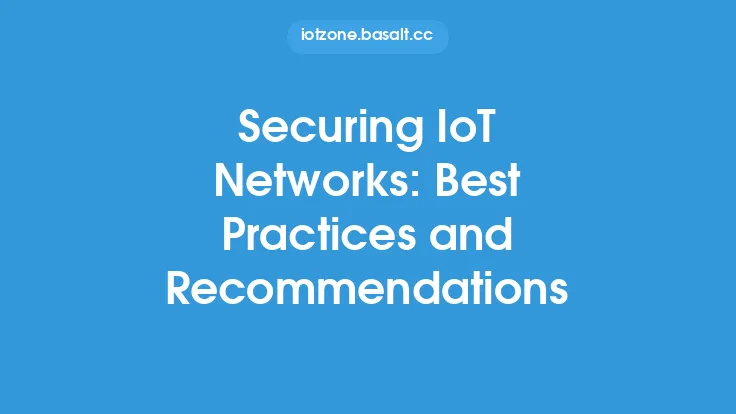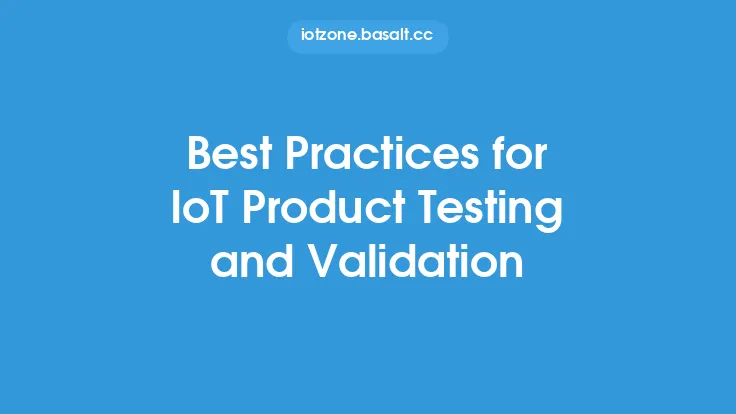The Internet of Things (IoT) has revolutionized the way we live and work, with billions of devices connected to the internet, collecting and exchanging data. However, this increased connectivity has also introduced new security risks, making it essential for manufacturers and users to take steps to secure IoT devices. In this article, we will discuss the best practices for securing IoT devices, including secure design, secure coding, secure communication, and secure maintenance.
Introduction to IoT Device Security
IoT devices are vulnerable to various types of attacks, including hacking, malware, and denial-of-service (DoS) attacks. These attacks can compromise the confidentiality, integrity, and availability of data, as well as disrupt the functioning of devices. Moreover, IoT devices often have limited computational resources, making it challenging to implement robust security measures. Therefore, it is crucial to adopt a multi-layered approach to security, incorporating both hardware and software-based solutions.
Secure Design Principles
Secure design is the foundation of IoT device security. Manufacturers should follow secure design principles, such as minimizing attack surfaces, implementing least privilege access, and using secure protocols for communication. Additionally, devices should be designed with security in mind from the outset, rather than as an afterthought. This includes conducting threat modeling and risk assessments to identify potential vulnerabilities and implementing countermeasures to mitigate them. Secure design principles also involve using open-source software and hardware, which can be reviewed and audited by the community, reducing the risk of hidden backdoors or vulnerabilities.
Secure Coding Practices
Secure coding practices are essential for preventing vulnerabilities in IoT devices. Manufacturers should follow secure coding guidelines, such as those provided by the Open Web Application Security Project (OWASP), to ensure that their code is free from common vulnerabilities like buffer overflows, SQL injection, and cross-site scripting (XSS). Additionally, code should be regularly reviewed and tested for security flaws, and vulnerabilities should be promptly addressed. Secure coding practices also involve using secure coding languages, such as Rust or Go, which are designed to prevent common programming errors that can lead to security vulnerabilities.
Secure Communication Protocols
Secure communication protocols are critical for protecting data transmitted between IoT devices and the cloud or other devices. Manufacturers should implement secure communication protocols, such as Transport Layer Security (TLS) or Datagram Transport Layer Security (DTLS), to encrypt data in transit. Additionally, devices should use secure key exchange protocols, such as Elliptic Curve Diffie-Hellman (ECDH), to establish secure connections. Secure communication protocols also involve using secure authentication mechanisms, such as public key infrastructure (PKI) or pre-shared keys (PSK), to verify the identity of devices and prevent unauthorized access.
Secure Maintenance and Updates
Secure maintenance and updates are essential for ensuring the ongoing security of IoT devices. Manufacturers should provide regular security updates and patches to address known vulnerabilities and fix security flaws. Additionally, devices should be designed to receive updates securely, using protocols like TLS or secure boot mechanisms. Secure maintenance and updates also involve monitoring devices for security incidents and responding promptly to security breaches. Manufacturers should also provide clear instructions and support for users to update their devices, making it easy for them to maintain the security of their devices.
User Best Practices
While manufacturers play a critical role in securing IoT devices, users also have a responsibility to follow best practices to ensure the security of their devices. Users should change default passwords and use strong, unique passwords for each device. Additionally, users should keep their devices and software up to date, installing security updates and patches as soon as they become available. Users should also use secure communication protocols, such as HTTPS, when interacting with their devices, and avoid using public Wi-Fi or unsecured networks to access their devices. Furthermore, users should monitor their devices for suspicious activity and report any security incidents to the manufacturer or relevant authorities.
Network Security Considerations
Network security is a critical aspect of IoT device security. Users should ensure that their network is secure, using measures like firewalls, intrusion detection systems, and virtual private networks (VPNs). Additionally, users should segment their network, isolating IoT devices from other devices and the internet, to prevent lateral movement in case of a security breach. Network security considerations also involve using secure routing protocols, such as Secure OSPF (S-OSPF), to prevent routing attacks and ensure the integrity of data transmitted over the network.
Physical Security Considerations
Physical security is often overlooked in IoT device security, but it is a critical aspect of protecting devices from tampering and unauthorized access. Users should ensure that their devices are physically secure, using measures like tamper-evident tape or secure enclosures. Additionally, users should limit access to devices, using measures like locks or biometric authentication, to prevent unauthorized access. Physical security considerations also involve protecting devices from environmental factors, such as extreme temperatures or humidity, which can affect their functioning and security.
Conclusion
Securing IoT devices requires a multi-layered approach, incorporating both hardware and software-based solutions. Manufacturers should follow secure design principles, secure coding practices, and secure communication protocols to ensure the security of their devices. Users should follow best practices, such as changing default passwords, keeping devices up to date, and using secure communication protocols, to ensure the security of their devices. By working together, manufacturers and users can ensure the security and integrity of IoT devices, protecting against cyber threats and maintaining the trust and confidence of users.





